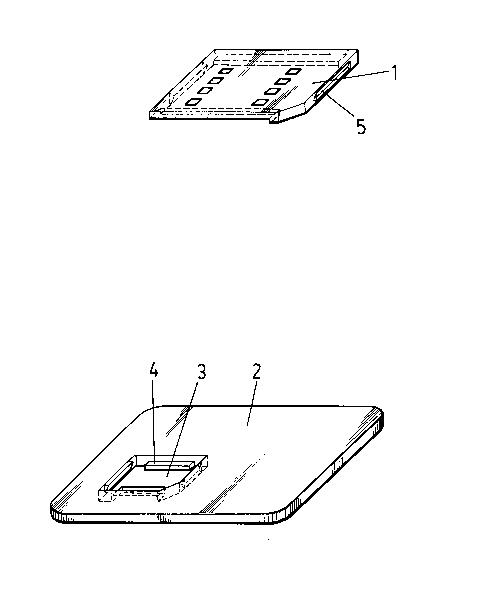Some of the information on this Web page has been provided by external sources. The Government of Canada is not responsible for the accuracy, reliability or currency of the information supplied by external sources. Users wishing to rely upon this information should consult directly with the source of the information. Content provided by external sources is not subject to official languages, privacy and accessibility requirements.
Any discrepancies in the text and image of the Claims and Abstract are due to differing posting times. Text of the Claims and Abstract are posted:
| (12) Patent Application: | (11) CA 2158530 |
|---|---|
| (54) English Title: | INTELLIGENT CARD USEFUL IN TELEPHONES AND THE LIKE |
| (54) French Title: | CARTE A PUCE POUR LE TELEPHONE ET SERVICES SIMILAIRES |
| Status: | Deemed Abandoned and Beyond the Period of Reinstatement - Pending Response to Notice of Disregarded Communication |
| (51) International Patent Classification (IPC): |
|
|---|---|
| (72) Inventors : |
|
| (73) Owners : |
|
| (71) Applicants : |
|
| (74) Agent: | RICHES, MCKENZIE & HERBERT LLP |
| (74) Associate agent: | |
| (45) Issued: | |
| (22) Filed Date: | 1995-09-18 |
| (41) Open to Public Inspection: | 1996-03-20 |
| Examination requested: | 2002-09-06 |
| Availability of licence: | N/A |
| Dedicated to the Public: | N/A |
| (25) Language of filing: | English |
| Patent Cooperation Treaty (PCT): | No |
|---|
| (30) Application Priority Data: | ||||||
|---|---|---|---|---|---|---|
|
Two types of subscriber identification modules (SIM)
exist in the field of mobile telephony, one type
conforming to the conventional ISO 7810/13/16 format and
the other type to the PrENV 1375-2 European pre-standard
format. In particular, the latter type uses a small
identification module on its own, and the first type uses
such module integrally with a larger plastic card. The
intelligent card of the invention is comprised by the
combination of a module (1) conforming to the European
pre-standard and a laminar sheet (2) having a window (3)
capable of housing therein said module (1) snugly to turn
into a chip card conforming to ISO standards, being
particular in that tonguing and grooving means (4-5) are
established between the edges of the module (1) and the
edges of the window (3) allowing said parts to be easily
coupled to and uncoupled from each other, to be used
jointly or separately, as required at each particular
instance.
Note: Claims are shown in the official language in which they were submitted.
Note: Descriptions are shown in the official language in which they were submitted.

2024-08-01:As part of the Next Generation Patents (NGP) transition, the Canadian Patents Database (CPD) now contains a more detailed Event History, which replicates the Event Log of our new back-office solution.
Please note that "Inactive:" events refers to events no longer in use in our new back-office solution.
For a clearer understanding of the status of the application/patent presented on this page, the site Disclaimer , as well as the definitions for Patent , Event History , Maintenance Fee and Payment History should be consulted.
| Description | Date |
|---|---|
| Inactive: IPC expired | 2009-01-01 |
| Application Not Reinstated by Deadline | 2004-09-20 |
| Time Limit for Reversal Expired | 2004-09-20 |
| Deemed Abandoned - Failure to Respond to Maintenance Fee Notice | 2003-09-18 |
| Inactive: Application prosecuted on TS as of Log entry date | 2002-09-26 |
| Inactive: Status info is complete as of Log entry date | 2002-09-26 |
| Letter Sent | 2002-09-26 |
| Revocation of Agent Requirements Determined Compliant | 2002-09-12 |
| Appointment of Agent Requirements Determined Compliant | 2002-09-12 |
| Inactive: Office letter | 2002-09-12 |
| Inactive: Office letter | 2002-09-12 |
| Request for Examination Requirements Determined Compliant | 2002-09-06 |
| All Requirements for Examination Determined Compliant | 2002-09-06 |
| Application Published (Open to Public Inspection) | 1996-03-20 |
| Abandonment Date | Reason | Reinstatement Date |
|---|---|---|
| 2003-09-18 |
The last payment was received on 2002-08-19
Note : If the full payment has not been received on or before the date indicated, a further fee may be required which may be one of the following
Please refer to the CIPO Patent Fees web page to see all current fee amounts.
| Fee Type | Anniversary Year | Due Date | Paid Date |
|---|---|---|---|
| MF (application, 2nd anniv.) - standard | 02 | 1997-09-18 | 1997-09-18 |
| MF (application, 3rd anniv.) - standard | 03 | 1998-09-18 | 1998-08-05 |
| MF (application, 4th anniv.) - standard | 04 | 1999-09-20 | 1999-09-17 |
| MF (application, 5th anniv.) - standard | 05 | 2000-09-18 | 2000-08-09 |
| MF (application, 6th anniv.) - standard | 06 | 2001-09-18 | 2001-09-11 |
| MF (application, 7th anniv.) - standard | 07 | 2002-09-18 | 2002-08-19 |
| Request for examination - standard | 2002-09-06 |
Note: Records showing the ownership history in alphabetical order.
| Current Owners on Record |
|---|
| FABRICA NACIONAL DE MONEDA Y TIMBRE |
| Past Owners on Record |
|---|
| FERNANDO PISONERO MONTES |
| MANUEL FERNANDEZ PEREZ |
| SANCHES CARLOS MONTEZ |